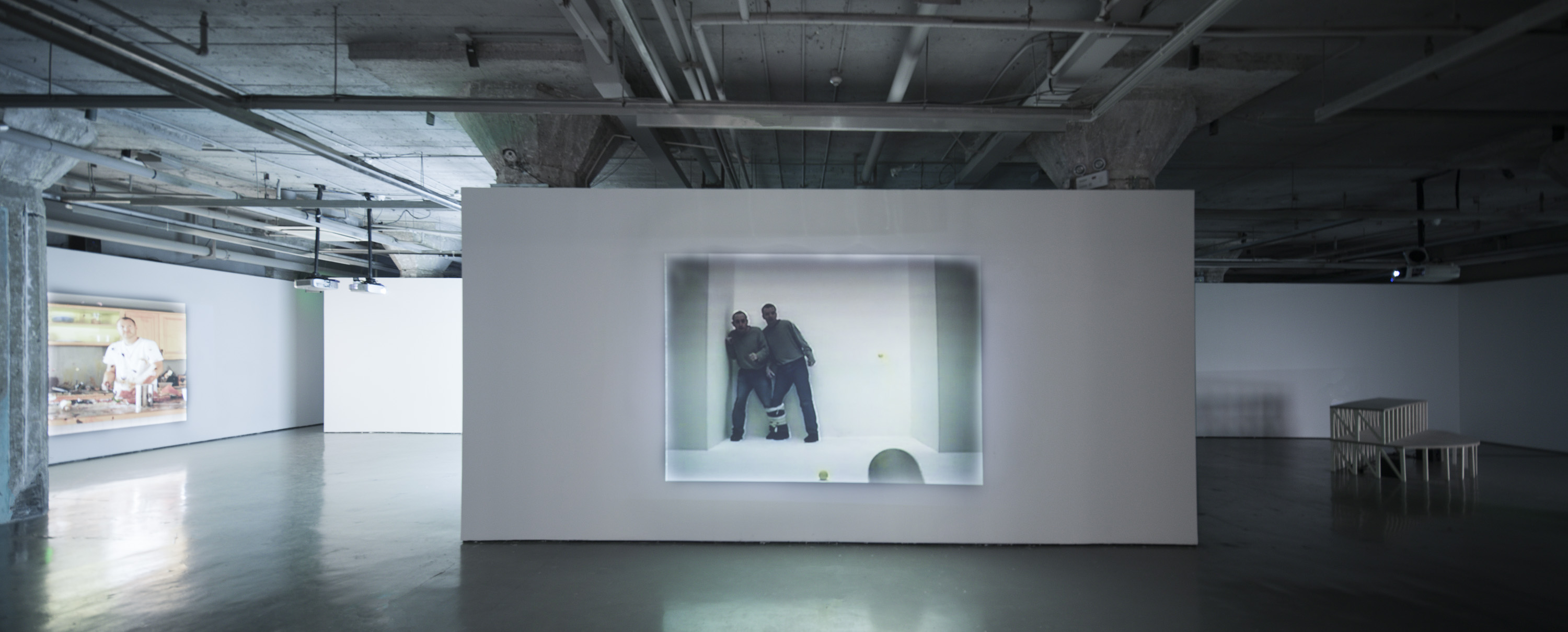Shows
On Struggling to Remain Present When You Want to Disappear


“On Struggling to Remain Present When You Want to Disappear,” an exhibition at OCAT Shanghai, presented in collaboration with arts non-profit organization Kadist, had an ambitious premise: to explore the nature of reality in contemporary experience. The design of the livery, employing a curtain of aqueous ones and zeros, appropriated from the 1999 science fiction movie The Matrix, augured a maze of technologically augmented experiences. This expectation was confounded—despite a preponderance of video, the approach proved to be Luddite, down to the division of the show into two parts, quaintly described as “chapters.” The first saw old-fashioned reverie as a response to harsh everyday conditions, while chapter two considered the interface of live action and the multiple realities of the screen.
Two of Pavel Wolberg’s photographs from 2004, both titled Hebron, set the tone from the start. In attitudes of defensive tension, soldiers on the streets of the titular West Bank city are a backdrop to children in fancy dress, presenting an absurd clash, as if childhood innocence needs a military guard.
Children similarly feature in Binelde Hyrcan’s film, Cambeck (2011). Seated in an imaginary limousine they have dug out of sand on an Angolan beach, the children boast to one another as they pretend to drive around the world. There is an obvious disjuncture between their fantasy of affluence and the unadorned location; imagination is not enough to transport them. The illusion falls apart as individual interests diverge and the children bicker—initially over details of the fantasy, such as who determines what is cool to play on the car’s radio, but subsequently, revealing the anxieties of their lives, over who has a “no-hope” future, and who will achieve a better life.
Meanwhile, the characters in Cao Fei’s video,Cosplayers (2004), turn to imaginative fiction in order to transcend their ordinary lives in unprepossessing urban surroundings. Seeking escape through a collective love of manga, the cosplayers wear the outfits of their favored characters, striking poses and staging fights. The work shows how collective investment in an alternate reality can be a form of resistance against drab conditions.
In chapter two, people were shown to be dispossessed, inconsistent and unreliable, compared to the durability and pitiless fidelity of digital technologies. American rapper Yung Jake’s music video, Unfollow - Art + Music – MOCAtv (2014), concerns the intricacy of severing social media links after a romance has played out. His song tells how “friending” on WeChat or Facebook is more permanent than human amity.
People are similarly outperformed by tech in 77 sqm_9:26min (2017), in which international collective Forensic Architecture meticulously recreates a real murder scene to explore human bias and the fallibility of memory. The discrepancies in a police witness statement, suggesting collusion or a cover-up, are tested in a computer model that exhaustively maps the subjects’ physical positions against a timeline, revealing sight lines and the dispersion of acoustic and olfactory information. The authority of the simulation appears to surpass clumsy subjectivity in the original interpretation of the same facts.
While these works present the real and virtual as distinct entities, Harun Farocki’s two-channel video, Serious Games III: Immersion (2009), invests the simulacrum with the power to affect the physical world. Set in a military training center, one screen shows a video-game-like battle environment; the other, how this induces real somatic effects in subjects. It is hard to decide if the soldiers in the latter screen, who express conflict trauma, are actors; and if incidents where stiff avatars are hit by missiles are aspects of a genuine therapeutic practice.
A different virtual “clout” was delivered by Tobias Fike and Matthew Harris in Food Fight (2013), and John Wood and Paul Harrison in 3 Legged (1997). Both video works show the impact of projectiles lobbed past the camera at subjects on screen. In the latter, a contraption shoots tennis balls at the artists, who are bound together and have to cooperate to avoid being hit. The artists’ lumbering illustrates an unequal arrangement—the humans are no match for the relentless machine.
In Food Fight, the set-up involves two screens facing one another, both showing kitchens that look like generic sets in TV cookery programs. Two deadpan chefs occasionally break their culinary demonstration to fling bits of food past the camera, which, through clever editing, land with a splat in the kitchen in the opposite screen. Reality is tangled on many levels—from the artifice of the actors pretending to be the legitimate TV chefs, battling in fake kitchens, to the real mess, smeared about, witnessed on the anodyne purity of the screen.
It was refreshing that the exhibition did not anticipate a hi-tech future with hackneyed dystopian visions, but rather challenged viewers’ assumptions of the real, considering the present with an archeological scrutiny that reflected how odd it is to find the merciless objectivity of intelligent machines now in such intimate collusion with beings of sentiment and imagination. Visitors found situations where the material and the fantastical often coexist, but where every hesitant mortal interaction will become an unforgiving digital trace.
“On Struggling to Remain Present When You Want to Disappear” is on view at OCAT, Shanghai, until June 10, 2018.







